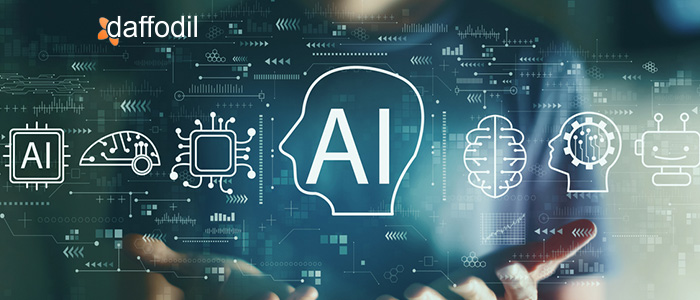
The global technology ecosystem has an insatiable demand for AI today but without the right training data and efficient AI model development, this domain cannot be utilized to its full potential. With fully actualized AI models that arise from high-quality build lifecycles, continuous innovation in AI fields such as Natural Language Processing (NLP) or predictive analytics can be ensured.
Specificity in the business implementation of AI, especially in sub-fields such as NLP, personal assistants, chatbots, etc. requires a holistic approach to the building of AI models. Several aspects of this process such as finding skilled AI scientists, cleaning and preparing good data, accumulating subject matter expertise, and so on have to be efficiently fulfilled.
Further in this article, we will discuss the best methodologies and strategies that can ensure the optimal development of AI models.
What Is An AI Model?
AI models are software programs with underlying Machine Learning (ML) algorithms that learn from task-specific data and fulfill the intended business objective. They are trained on several sets of data so that they learn to identify patterns in them and use the learnings to apply to the task at hand.
While it is said that all machine learning models are AI models, the inverse is not true. The primary intent behind building AI models is to train machines to perform tasks in a way that mimics human intelligence. Machine learning model building is concerned with bypassing the need for programming every step of the intended task into the AI model and allowing the model to learn from patterns and experience.
Tips For Efficient Development Of AI Models
The current AI marketplace calls for greater democratization of AI so that it reaches a wider user base that lacks a low-level understanding of this technology. For this to occur, there needs to be greater precision in the development of underlying AI models. Here are some tips for the same:
1)Clearly Defining Pain Points
A promising approach for building AI models is suggested by renowned AI scientist Andrew Ng, who formerly built efficient AI models for Google and Baidu. He advises AI-based developers to view AI applications as business problems right from the get-go.
It is highly paramount that you define your expectations from the development of the model, how exactly it can improve existing business processes, and what kind of resources you can assign towards AI model building. There is no single approach to identifying the business problem, but defining it in clear terms from the outset is important.
2)Data Collection And Preparation
The accuracy of AI models is directly related to the quality of data that they learn from. So it is important to identify, prepare and categorize the data before feeding it to the AI model. The right data sources compatible with the business situation must be selected.
The data collected can be allocated to one of the following categories:
- Structured Data: Data that can be concisely arranged in matrices or rows and columns as in a spreadsheet, inventory management software, or a database.
- Unstructured Data: Data that can simultaneously exist in multiple formats and that cannot be arranged in the form of a basic spreadsheet, e.g., videos and images.
3)Creating And Training Algorithms
How the AI model turns out depends on the machine learning algorithm used to build it. You can choose among algorithms such as supervised learning, and unsupervised learning algorithms. The algorithms then map how the dataset converts to the intended result for your business pain point.
Once the algorithm has been selected, the next logical step in the workflow is to train and retrain the algorithm until a benchmarkable level of accuracy is achieved. The accuracy must be maintained throughout the development of the AI model, which can only be done through constant retraining.
Customer Success Story: Daffodil develops an AI-powered license plate recognition app for efficient parking lot management
4)Platform Selection
Next comes the selection of the right platform for testing and deploying the AI model. The business problem may call for a particular type of framework for the platform. You can go for frameworks that allow for the development of the model internally such as Tensorflow or Pytorch. On the other hand, there is the option to go for ML-as-a-Service platforms for training and deploying the model at a very fast pace. IDEs such as Jupyter Notebooks provide feature-rich graphical user interfaces for your purpose.
5)Programming Language
While selecting a programming language for your AI model make sure that the language provides for a comprehensive set of ML libraries and other dependencies. The language you choose also depends on the learning curve that is ideal for you and the associated platform you are working with.
You can go for C++ if you are opting for a language that can manage the modalities of gamification, Python is a good option in case the learning curve must be kept minimal, and Java is a user-friendly option that can be debugged easily.
.jpg?width=1000&name=blog%20image%20(4).jpg)
6)Building Subject Matter Expertise
Consulting with a Subject Matter Expert (SME) during various phases of the AI model creation process is a great facility that can be availed for covering all facets thoroughly. An SME can properly provide direction to your AI model creation to include the right features to develop a holistic business solution. There might be multiple features that make sense at the moment but may be irrelevant at the time of deployment. SMEs can help you carefully avoid these paradoxes in the model building process.
7)Training The Model
When all other aspects of the AI model are set up, you can begin with the definition of features of the model to serve your particular business requirement. Some particulars to train the model for include the time cycles of AI development, the accuracy of the models, relevance of features, and so on.
It is essential to train the model before deployment and then test it continuously after deployment to ensure that it completes the tasks it has been modeled for in an optimal manner.
8)Continuous Monitoring
Once the model is deployed, dedicated experts need to keep an eye on it for validating its performance based on the parameters decided at the beginning. Based on the initial business requirements, the model can be monitored for performance.
If the model does not perform as expected, it must be taken back to the drawing board and looked at with a fresh perspective. The AI scientists can then develop the model along the lines of the initial business parameters decided on at the outset.
9)Good Governance
Just like there are good coding and testing practices, AI model development must also be gauged with a thorough barometer of performance. It must be observed whether the model adapts to changes along the lines of the deployment environment, and the context of the business requirement.
Other deviations in the environments in which it is expected to function in may include natural disasters or the complete rehashing of the way businesses are carried out such as what happened during the pandemic.
ALSO READ: All About Artificial General Intelligence: The Next Frontier in AI
10)Time And Effort Optimization
As per Algorithmia's published report, titled 2020 State of Enterprise Machine Learning, 40% of companies surveyed revealed that they could deploy an ML model in a little over a month. About 28% of these companies could do so in less than a month, and 14% in seven days or less.
What these companies differed in was the allocation of time and human resources and prioritization of particular skills. A 2019 survey revealed that about 78% of all AI model development projects slow down to almost a halt near the deployment phase.
With Daffodil's AI Development solutions, you can expect that your AI-based digital solution has a minimal time-to-market, high-quality performance, and optimal personalization to serve your customer base in the best possible way.



